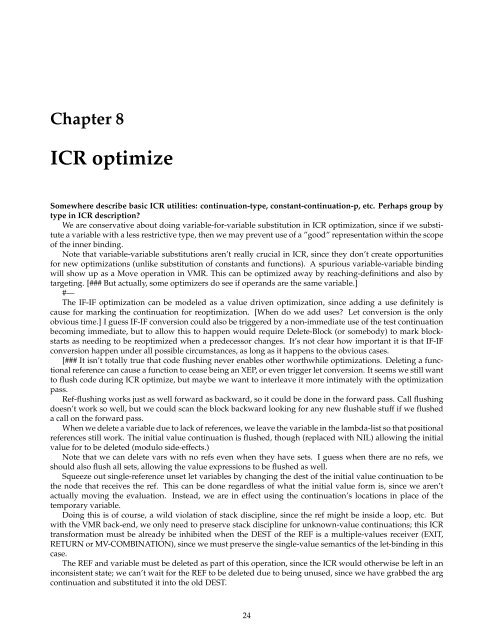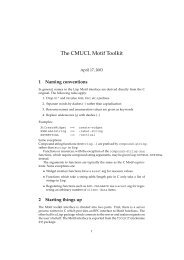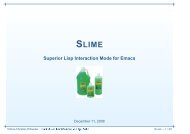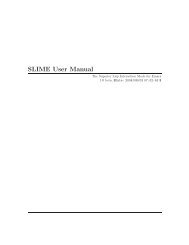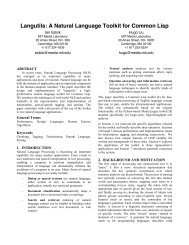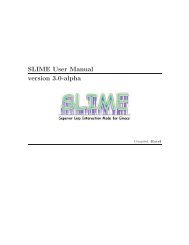Design of CMU Common Lisp.pdf - Common Lisp.net
Design of CMU Common Lisp.pdf - Common Lisp.net
Design of CMU Common Lisp.pdf - Common Lisp.net
Create successful ePaper yourself
Turn your PDF publications into a flip-book with our unique Google optimized e-Paper software.
Chapter 8<br />
ICR optimize<br />
Somewhere describe basic ICR utilities: continuation-type, constant-continuation-p, etc. Perhaps group by<br />
type in ICR description?<br />
We are conservative about doing variable-for-variable substitution in ICR optimization, since if we substitute<br />
a variable with a less restrictive type, then we may prevent use <strong>of</strong> a ”good” representation within the scope<br />
<strong>of</strong> the inner binding.<br />
Note that variable-variable substitutions aren’t really crucial in ICR, since they don’t create opportunities<br />
for new optimizations (unlike substitution <strong>of</strong> constants and functions). A spurious variable-variable binding<br />
will show up as a Move operation in VMR. This can be optimized away by reaching-definitions and also by<br />
targeting. [### But actually, some optimizers do see if operands are the same variable.]<br />
#—<br />
The IF-IF optimization can be modeled as a value driven optimization, since adding a use definitely is<br />
cause for marking the continuation for reoptimization. [When do we add uses? Let conversion is the only<br />
obvious time.] I guess IF-IF conversion could also be triggered by a non-immediate use <strong>of</strong> the test continuation<br />
becoming immediate, but to allow this to happen would require Delete-Block (or somebody) to mark blockstarts<br />
as needing to be reoptimized when a predecessor changes. It’s not clear how important it is that IF-IF<br />
conversion happen under all possible circumstances, as long as it happens to the obvious cases.<br />
[### It isn’t totally true that code flushing never enables other worthwhile optimizations. Deleting a functional<br />
reference can cause a function to cease being an XEP, or even trigger let conversion. It seems we still want<br />
to flush code during ICR optimize, but maybe we want to interleave it more intimately with the optimization<br />
pass.<br />
Ref-flushing works just as well forward as backward, so it could be done in the forward pass. Call flushing<br />
doesn’t work so well, but we could scan the block backward looking for any new flushable stuff if we flushed<br />
a call on the forward pass.<br />
When we delete a variable due to lack <strong>of</strong> references, we leave the variable in the lambda-list so that positional<br />
references still work. The initial value continuation is flushed, though (replaced with NIL) allowing the initial<br />
value for to be deleted (modulo side-effects.)<br />
Note that we can delete vars with no refs even when they have sets. I guess when there are no refs, we<br />
should also flush all sets, allowing the value expressions to be flushed as well.<br />
Squeeze out single-reference unset let variables by changing the dest <strong>of</strong> the initial value continuation to be<br />
the node that receives the ref. This can be done regardless <strong>of</strong> what the initial value form is, since we aren’t<br />
actually moving the evaluation. Instead, we are in effect using the continuation’s locations in place <strong>of</strong> the<br />
temporary variable.<br />
Doing this is <strong>of</strong> course, a wild violation <strong>of</strong> stack discipline, since the ref might be inside a loop, etc. But<br />
with the VMR back-end, we only need to preserve stack discipline for unknown-value continuations; this ICR<br />
transformation must be already be inhibited when the DEST <strong>of</strong> the REF is a multiple-values receiver (EXIT,<br />
RETURN or MV-COMBINATION), since we must preserve the single-value semantics <strong>of</strong> the let-binding in this<br />
case.<br />
The REF and variable must be deleted as part <strong>of</strong> this operation, since the ICR would otherwise be left in an<br />
inconsistent state; we can’t wait for the REF to be deleted due to being unused, since we have grabbed the arg<br />
continuation and substituted it into the old DEST.<br />
24


